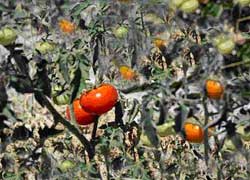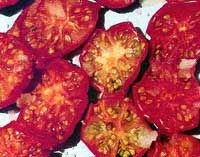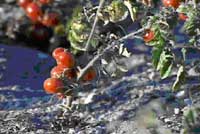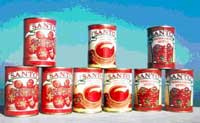Santorini cherry tomatoes
A vegetable that needs no water to grow
This tomato species was a rather late arrival on the island. It was first introduced in 1850. It is small, bright red in colour and slightly flat on the sides, with an acescent taste. This species adjusted well to the volcanic terrain, the strong winds and the high temperatures. It also adjusted to the dry conditions of the soil. This vegetable sustains itself with the meager quantities of water the humid summer nights can avail. The water vapours are stored in the ground and in the leaves of the plant. Years later, other tomato species flourished on the island: a more hardy species from the isle of Kos (which is sweeter than the Santorini cherry tomatoes), and the bournela, another variety the size of a small egg with an acute sour taste. Currently the Santorini cherry tomatoes are cultivated only in limited garden patches, while the output is standardized by the local Agricultural Association and the “Pvlo-Petrou Economou Co.”
These tomatoes are seeded by the end of February and the seedlings are thinned in April. Subsequently, they are transplanted and the fruit is collected by mid-june.
The Santorini tomato-balls (pseftokeftedes) are made from the mashed flesh of this fruit and taste delicious. You can find the Santorini cherry tomatoes in the form of canned tomato paste, which is ideal for giouvetsi recipes. Also the same vegetable if sun-dried and stored in jars with olive oil, can be used in spaghetti recipes and other dishes.


Why the Santorini cherry tomato is one of a kind?



It is a bushy plant which bears small fruit with skin, emulating in size the cherries. The soil it grows is also unique: dry, volcanic earth. The result of this combination is a sweet and mildly sour fruit infused with the aromas of a season long forgotten. The unique vegetable is cultivated, processed and packaged with extreme care by the last remaining factory on the island of Santorini. You will find it in all major supermarkets or vegetable outlets either as is, canned or as tomato paste and juice. The Santorini cherry tomato is ideal for cooking as it allows superb possibilities for exceptional tastes.
The old folks on the island of Santorini claim that the seeds of this tomatospecies originated from the Suez Canal, were Greek sailors tasted the fruit and liked it so much that they decided to bring seeds of the same back to Santorini. The seeds flourished in a soil that was as dry as that of Egypt.
To sustain the cultivation of this tomato species the R & D department of the Union of Theraic Products has plans for a pilot project involving experimental cultivation of cherry tomatoes in alternative soils applying new techniques. Soon, this tomato will come under the dinstinctive title PDD (Protected Designation of Origin).
Initially, the processing of the Santorini cherry tomatoes was more of a family affair. However, in 1915 mechanical processing started in small factories established on the island. Before the earthquake of 1956 there were 11 such factories for processing and canning of these Santorini tomatoes.
